With a Mad Max headlight, neat paint, tough stance and a stonking M8 114, it's no wonder the Fat Bob is such a cool Harley... Zane spent a few weeks doing rolling burnouts Photos: Impact Photography
Harley-Davidson bikes had never been my thing, I’m not too sure why, the big, loud and heavy machines are a far cry from the 250 two-strokes that sat at the top of my favourites list. But after riding the 2022 Fat Bob, I think I’ve been converted. Here’s my review.
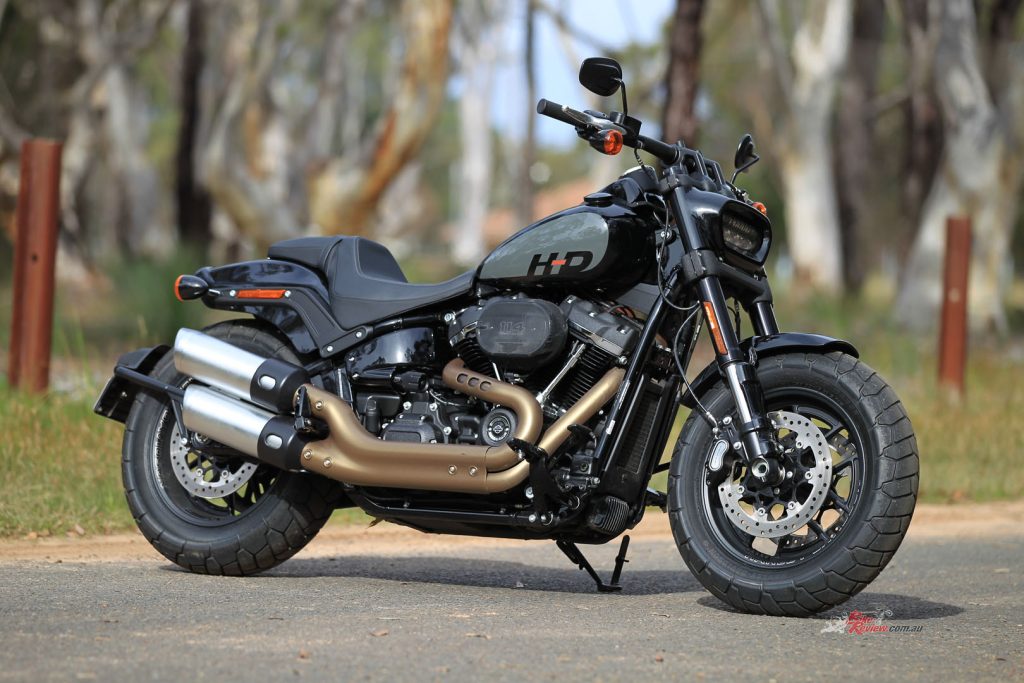
Zane says that Harley’s have never been his thing. Having never given them a real go, could the 2022 Fat Bob change his mind?
As a professional motorcycle journo for a number of years now, I get to ride all sorts of bikes on a weekly basis for review, however, everything I own personally is small capacity. I daily drive a 550cc truck, have a 660cc weekend car and a 1600cc race car, not only this but I always opt for the under 400cc bikes. It comes down to the fact that I like getting the most out of something, using minimal brakes and keeping the throttle pinned 24/7…
Check out our other cruiser reviews here…
Harley-Davidson to me are the “muscle car” equivalent of the bike world. Generalising the brands line-up, excluding the Pan America, they’re not made to go fast through corners, they’re made to look and sound tough and to cruise. This is why the brand never appealed to me. In fact, before the Fat Bob I had only ever ridden two other Harley’s, the Street 500 and a Fat Boy, both of which I only spent maybe an hour or less riding. Since then, my taste has matured a lot, I’m in my early 20s, I don’t like going mach-10 constantly and I can appreciate the art of just going out for a cruise, I had no idea I would actually enjoy the ride as much as I did.
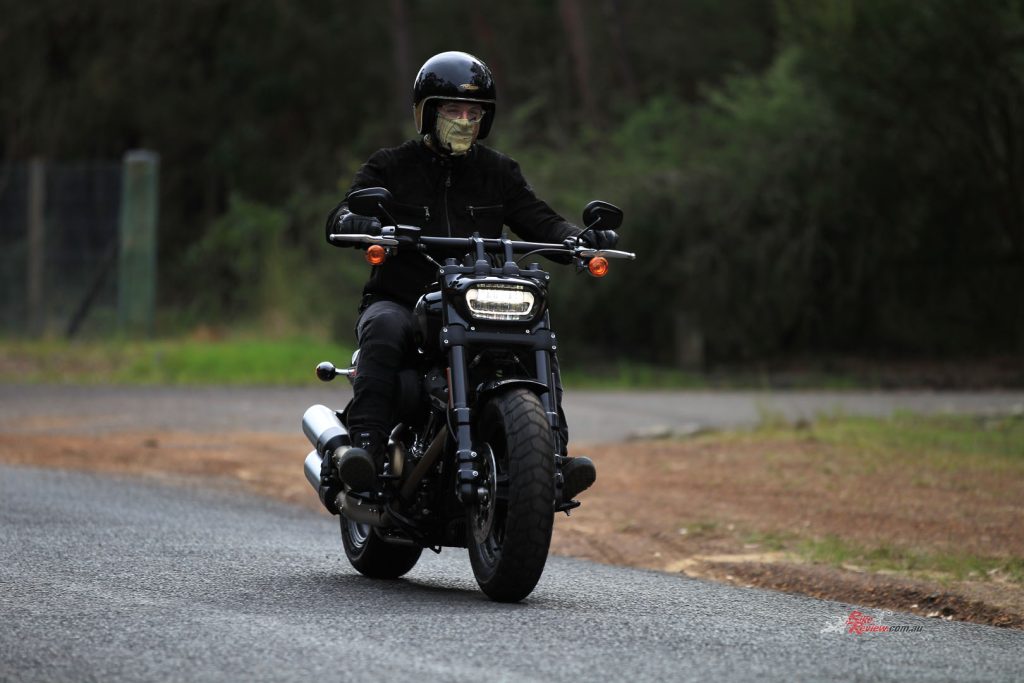
No traction control, plenty of torque and constant wet roads? Sounds terrifying and exhilarating at the same time…
I have some sort of curse on me that causes the heavens to open up whenever I’m booked into ride a bike. On the way to Frasers motorcycles in Wollongong, sure enough it was raining. Jeff had given me fair warning that the Fat Bob was going to be nothing like the bikes I’m used to.
First look around the bike and damn! I never thought I’d like the look of a stock Harley this much. The Fat Bob I was given was in the base Vivid Black colour scheme, it suited this angry machine just fine. There are two other colours that will run you an extra $355 but I don’t think they capture the muscular appeal of the Fat Bob as Vivid Black does.
The LED headlight looks like it drew inspiration directly from one of the Mad Max machines and how are those bronze exhaust pipe covers?! Awesome! The tail section compliments the bike, uninterrupted by a pesky licence plate. It does look Harley-Davidson didn’t worry about putting too much effort into designing the indicators and plate holder as these are often the first things to be replaced with a more subtle setup, or at least they are for me. With those mods, the bike would look seriously angry.
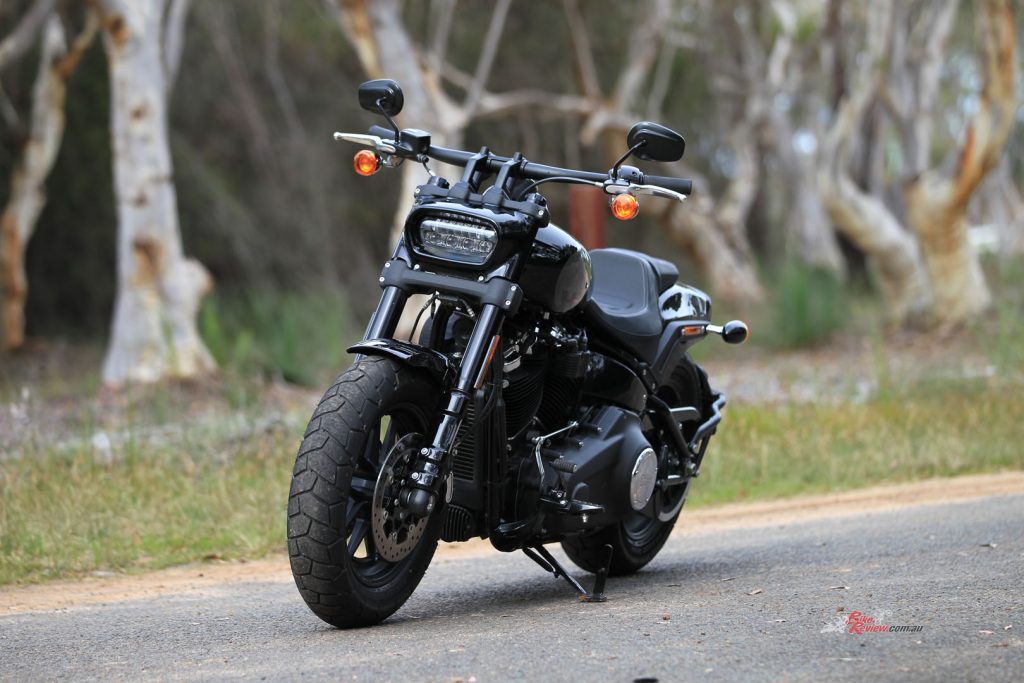
All up, Harley did an amazing job making the Fat Bob look minimalistic but hard hitting… We love it.
Sure enough, riding the Fat Bob home in the rain was a nerve-racking experience. No traction control, tyres feeling like they’ve just come out of the fridge and bucket loads of torque… It was kind of fun! The initial ride home left me wanting more, I hadn’t wanted to go for a long ride as badly as I did when I had the Fat Bob for a long time, I wanted to see what the bike was truly like. A few days later the sun decided to come out and I took the bike on a 250km round trip….
“No traction control, tyres feel like they’ve just come out of the fridge and bucket loads of torque… it was kind of fun!”
On the freeway, the Fat Bob sat on 110km/h easily. The gearing was setup perfectly so your speed wouldn’t be fluctuating constantly and when it came time to overtake, that awesome Milwaukee-Eight V-Twin would have all the grunt you could ever need…
Right in the number one spot on the list of things I loved about this bike has to be the 114ci Milwaukee-Eight engine. This engine was one of the smoothest and well responsive conventional V-Twin’s I’ve ever ridden, Harley made it so well they had to refine the balancers in the bottom end to have at least a little bit of vibration, so it would still feel like a true Harley-Davidson!
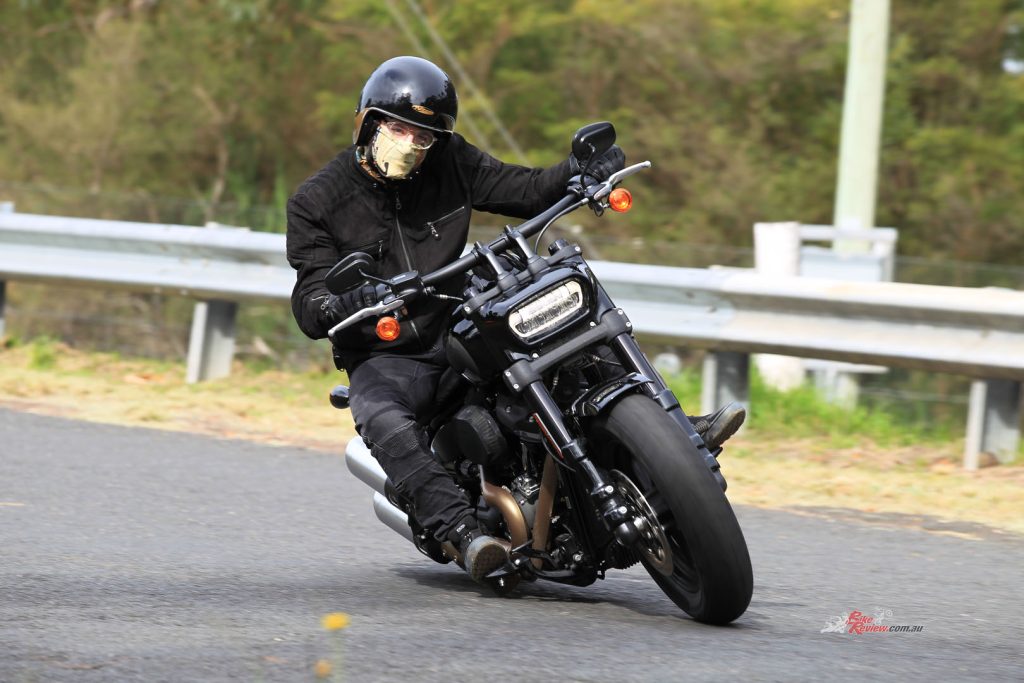
Loading the power on suddenly when exiting the corner and taking some weight off the rear will make the Fat Bob light up that rear wheel with ease!
Something I hadn’t experienced on other bikes was the machines desire to spin the rear wheel at any chance it got. From a sportsbike riders perspective, dropping the clutch would throw the front wheel up in the air, the Fat Bob would roast the rear tyre until it ran out of revs. This was obviously tested on a private road, although the desire to do it at every chance I got was overwhelming, the only thing stopping me was the thought of my licence being up cut up in front of me!
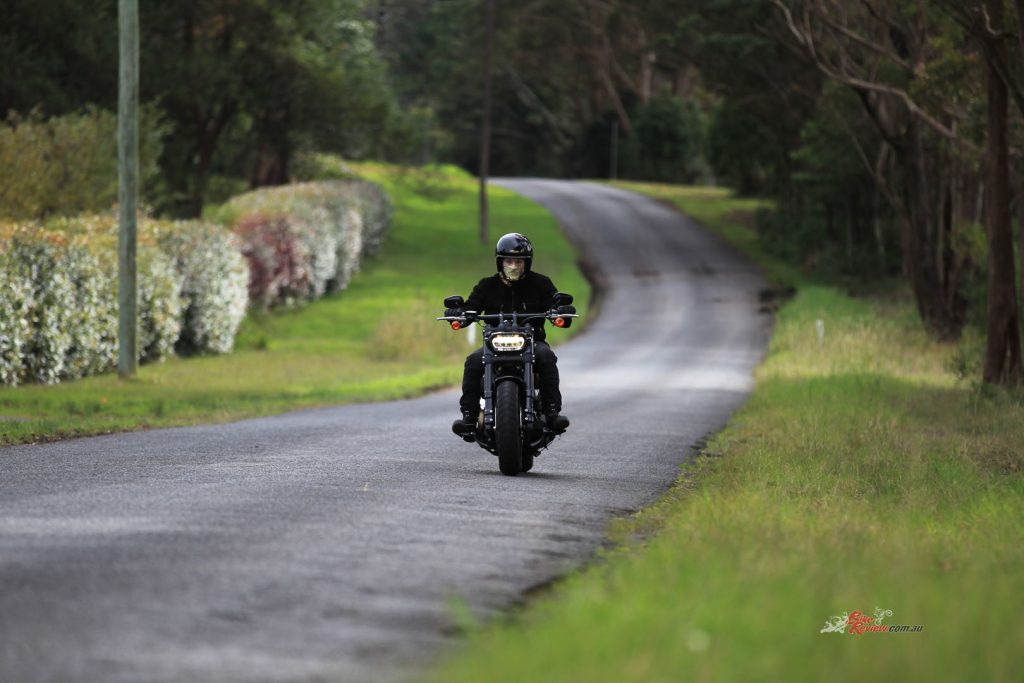
The Fat Bob would reach redline extremely quickly in the low gears, just a shift up to add more face melting torque.
At first, it felt like the Fat Bob was running out of revs far too quickly, but as I looked down at my speedo, that wasn’t the case. Peak torque is set at just 3,500rpm but it would reach the rev limiter very quickly, with the airfilter hanging off the side of the engine sounding like it wanted to suck in some low flying birds… It sounds like H-D have mapped the engine to have a “ghost cam” (fake lumpy cam) as it was super smooth at low revs but would stagger rpms a lot on idle.
Heading up the twisty roads of Jamberoo, I found myself tip toeing around the torque. While the Dunlop D429F hoops looked awesome on the bike, they were poor in terms of grip. The bike was slipping and sliding the whole way up the mountain, I was egging them on a little bit but my smile soon faded as I nearly high-sided out of an intersection. Maybe time to take it easy.
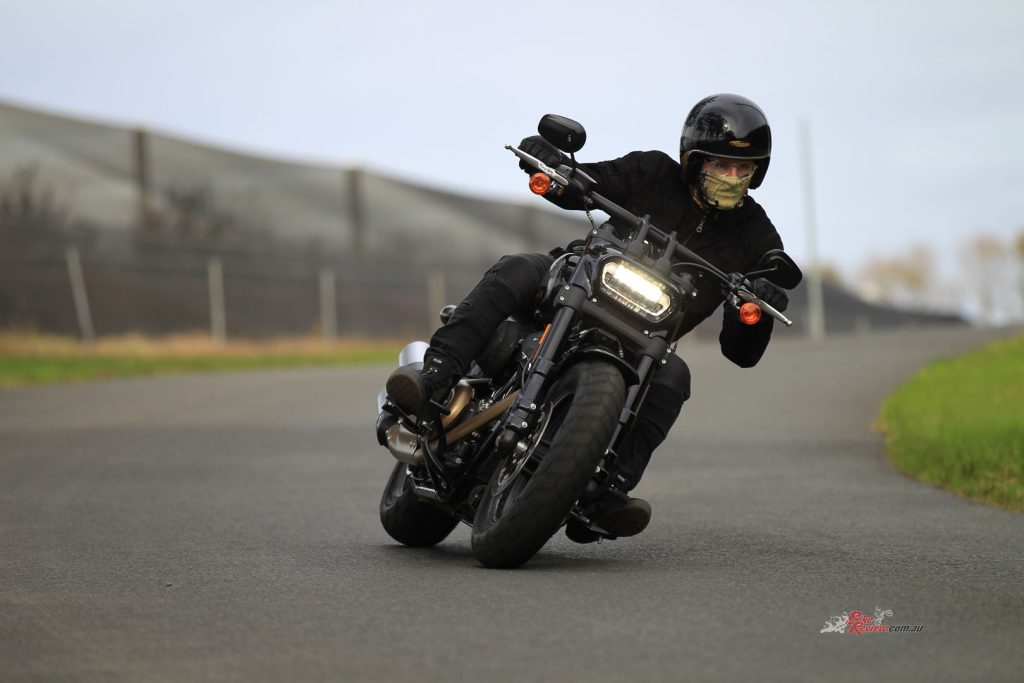
A relaxed riding position means you’re left feeling comfortable but with the ‘pegs placed a bit further back from the traditional cruiser style, you feel like you have a bit more control.
The riding position isn’t what I would call traditional Harley, it sat in-between the laid back cruiser position and a nakedbike. This helped me enjoy the ride a bit more through the twisities, giving me more confidence to lean the bike over without feeling like I was sitting on a recliner sofa. After a few hours of non-stop riding, I did feel my legs cramp up as the ‘pegs were a little too close for my long legs. The coil pack and airfilter were in really annoying spots, I would look down and my knee would have pulled off the filter net and I don’t doubt that I could probably knock one of the ignition leads off by accident too.
The seat holds you in like a cradle, it has a tremendous amount of back support too. Despite the bike only have a few hundred km on the odo, it felt nice and soft, my usual complaints of a firm seat have finally been silenced! The pillion seat is pretty small, I’d look at removing it if I owned the Fat Bob to show off more of that minimalist tail section, although that would most likely require an aftermarket seat, which there are plenty of.
I have to put plenty of praise on the handlebars, you don’t notice nice quality ‘bars until you spend time riding a bike with some and then hopping on a bike with subpar handlebars. They were thick and sturdy with no rattles or flexing, it helped give the bike a premium feel. The grips were awesome and the levers felt immaculate. The only thing I didn’t like about them were the indicator switches, absolute pain in the ass to get my head around the self-cancelling buttons on each side, they also weren’t tactile enough with gloves on and needed a bit too much pressure to push down.
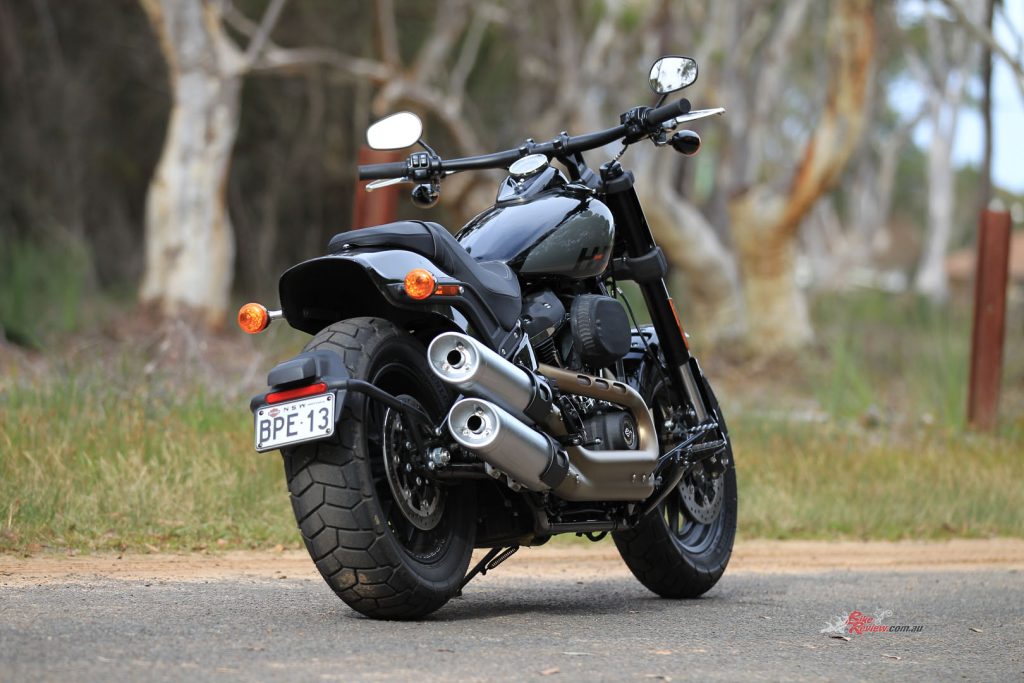
“I have to put plenty of praise on the handlebars, you don’t notice nice quality ‘bars until you spend time riding a bike with some and then hopping on a bike with subpar handlebars.”
The clutch felt amazing, I didn’t even nearly stall once and the bike seemed to have more than enough idle rpm to not need any throttle input to get moving. The gearbox gearing was superb but the actual gear change action was less than desirable, I can see Harley aiming for a “mechanical” feeling with the box but coming from a sportbike background, needing to use the clutch on up and down shifts felt clunky, not to mention the rear wheel would lock up briefly when kicking the gears down without clutch. This is something seasoned customers of the brand would be used to but if you’re moving from a sportsbike, it’s something to keep in mind.
The bike wont start unless it’s in neutral, with the clunky box I found it more difficult than usual to find neutral. Pulling up to the lights and by the time I had flicked up and down on the ‘box about 20 times to find it, the light would go green.
Harley-Davidson actually invented the side-stand for motorcycles. The story has been told a million times about how the bike feels like it’s going to fall over when you put them on their “jiffy-stand”, but it’s a pretty neat design and made it slightly easier to get it up and off the stand despite its weight because of the locking mechanism.
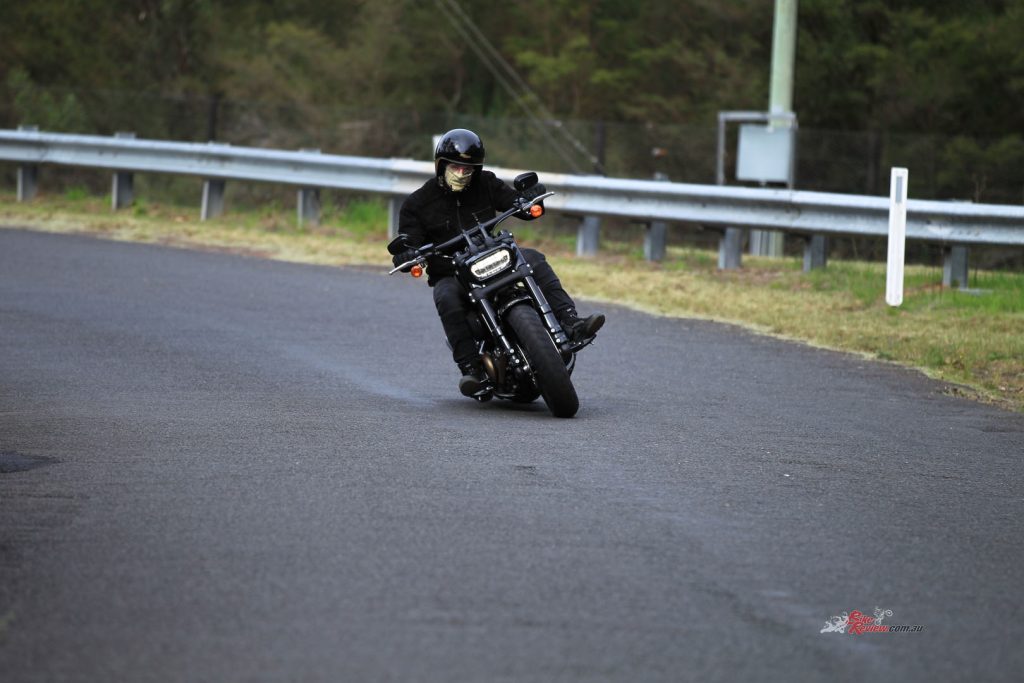
Harley-Davidson took some inspiration from race bikes and went with an upside down fork setup. Zane says the whole front-end is confidence inspiring.
The suspension was immaculate, Harley-Davidson say they drew inspiration from race bikes with their upside down fork setup, the whole front end felt amazing and worked in well with the whole chassis. I have a bad back for someone in their early 20s, so a bad rear shock is something I pick up on quickly, I can confidently say the Fat Bob’s rear shock has been set up well. There was a remote hydraulic preload adjuster but it didn’t need to be changed from the factory setting, so I didn’t worry about messing with it.
The brakes didn’t stand out to me, they weren’t bad but they weren’t amazing. The front required more pressure than I’d usually apply to other bikes but it’s also a much heavier ride than what I’m used to. ABS worked well as I didn’t feel any lock ups in the front or the rear, even with the grip-less tyres in the rain, emergency stops brought the 306kg beast to a halt with no worries.
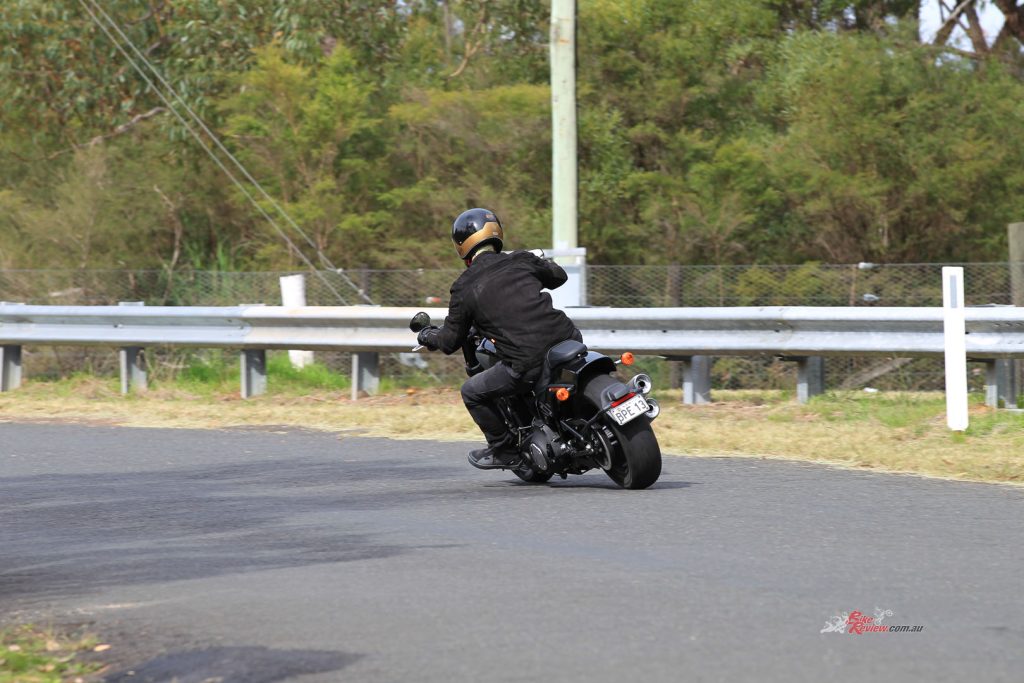
The Fat Bob features minimal electronic assists… and by minimal we mean it just has ABS and nothing else.
Moving onto the electronics department and this is where the Fat Bob let me down. The bike had no assists at all, besides ABS, it was screaming out for a traction control system the entire time was riding it. Most traditional Harley riders will be calling that sacrilegious, but even just a rain setting would benefit the bike heavily, like I said it was slipping and squirming all over the place. There is also no TFT dash and the LCD display under the analogue tacho was pretty basic.
One piece of technology the Fat Bob did have was a key fob, my arch nemesis, I cannot stress how much I miss just putting a key in the ignition and turning it instead of stressing about where I’ve put the key fob. The Fat Bob also has an alarm system which will freak out if you lift the bike off the stand without the key nearby, I tried to move it in the garage with the key inside and it didn’t like that at all, good to know it works well.
“Overall, it’s safe to say I enjoyed my first proper Harley-Davidson experience, it was something different from my usual choice and it completely changed my opinion on the brand as a whole.”
Overall, it’s safe to say I enjoyed my first proper Harley-Davidson experience, it was something different from my usual choice and it completely changed my opinion on the brand as a whole. I found myself looking forward to ride it and not feeling the need to go anywhere at a high rate of speed, just sit back and enjoy the ride.
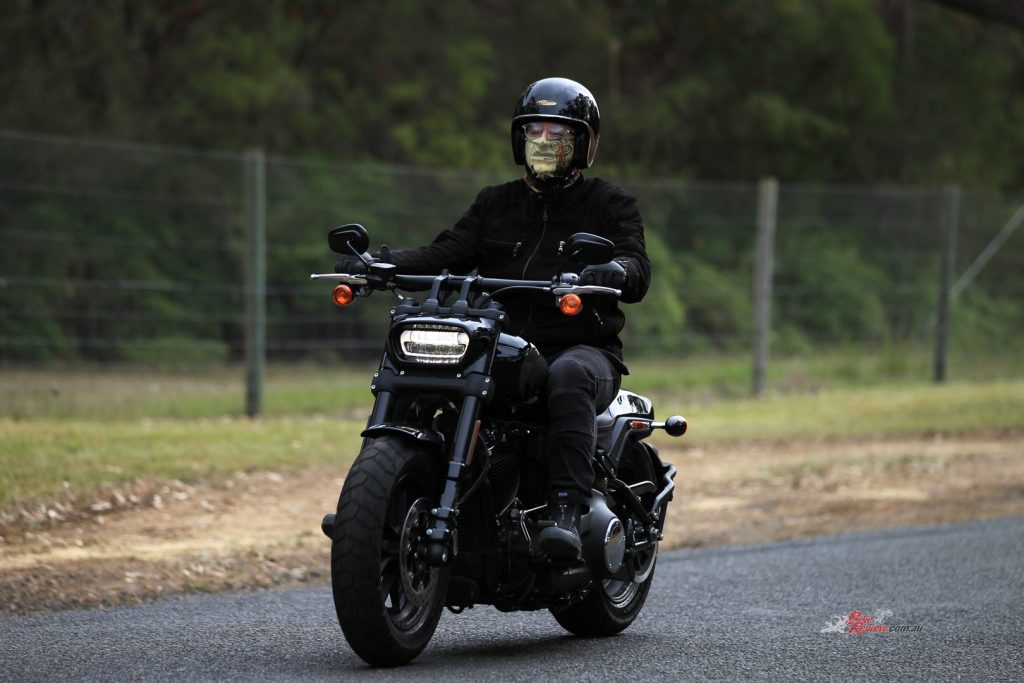
“I found myself looking forward to ride it and not feeling the need to go anywhere at a high rate of speed, just sit back and enjoy the ride.”
I will say, the price shocked me. Just under $32,000. You get a quality feeling bike and a badge but no assists and no technology. This did put me off the thought of buying one, you might be in a financial position to say “$32k? That’s nothing” but put into the perspective that you can ride away on SIX Honda Grom’s for that price and still have some cash in your back pocket!
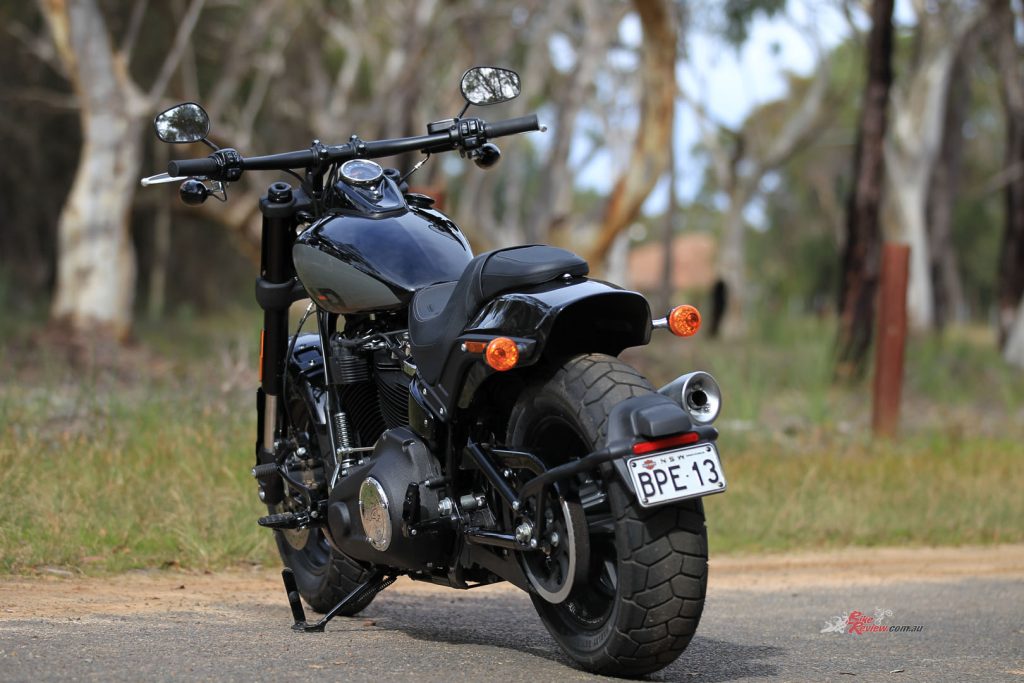
You can ride away on a 2022 Fat Bob from $31,750 in Vivid Black and $32,105 in the other two colours.
With that being said, would the low capacity sportsbike fan buy one? Yes, if I had the money to throw around I would absolutely have a Fat Bob in the garage. They’re an awesome bike and the build quality is second to none…
Tech Talk 2022 FXFBS Fat Bob 114
Harley-Davidson say the Softail chassis offers the look of a classic hardtail frame, but is underpinned by modern suspension for a smooth ride and outstanding handling. A single coil-over shock located between the frame and swingarm is out of view below the seat.
Harley-Davidson say they took inspiration from race bikes with the upside down fork setup. The single cartridge 43mm inverted forks with aluminium fork triple clamps and triple rate springs help inspire confidence in the front end and soak up the bumps with ease. The rear is sorted by a hidden, free piston, coil-over monoshock with 56mm stroke and features toolless hydraulic preload adjustment.
The Fat Bob shares the same platform as the Street Bob we have tested here. There are a few key differences between the two model though, the exhaust design is different, the fat bob is taller and longer overall, the weight difference sees the Fat Bob put on just under 10kg. Obviously, they’re completely different looking bikes, the Fat Bob adopts some chunky tyres at both the front and rear…
The chassis design is optimised to reduce weight without sacrificing stiffness. The rigid-mounted Milwaukee-Eight V-Twin engine further stiffens the entire chassis and contributes to a platform that delivers strong acceleration and responsive handling and braking performance.
The Milwaukee-Eight engine, the ninth Big Twin design in the company’s storied lineage, is a clean-sheet design that combines the classic look, sound and feel of Harley-Davidson Big Twin engines with improvements in every aspect of engine performance.
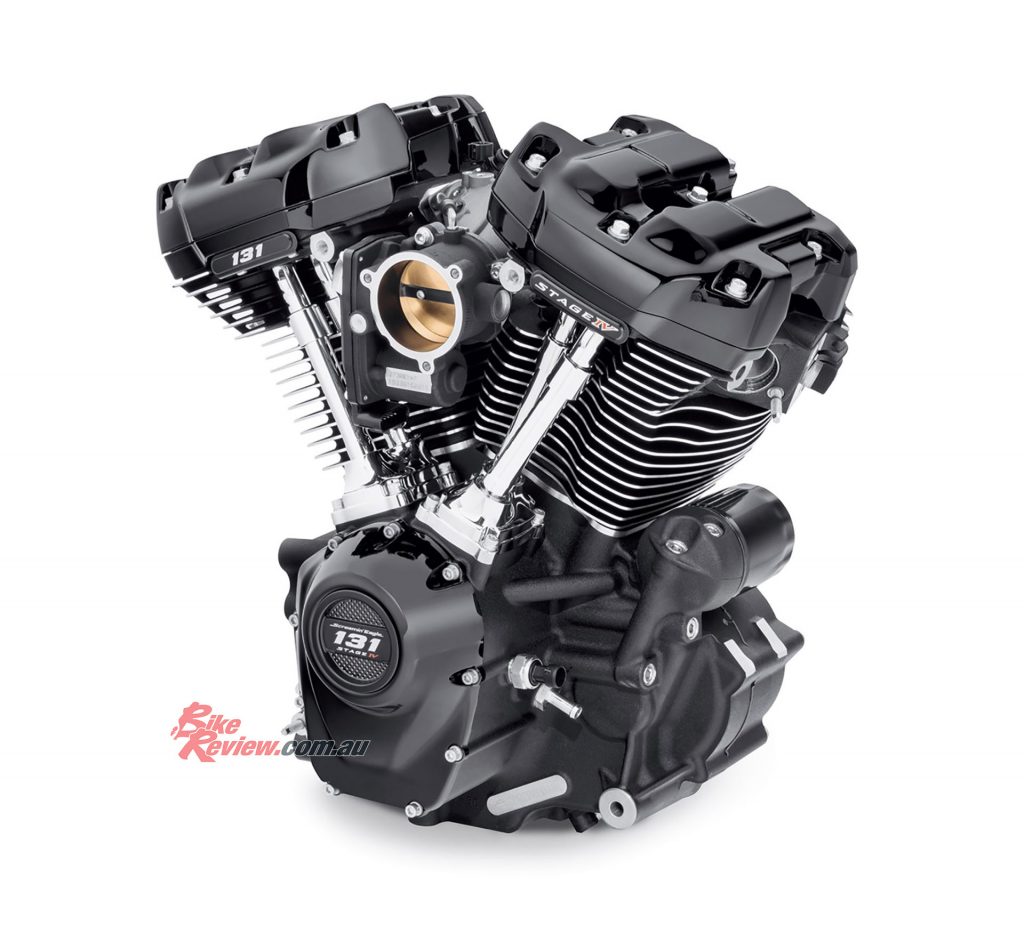
The Milwaukee Eight has been the heart for many Harley-Davidson models for over six years now, and it’s still an awesome engine.
Retaining the classic 45-degree V-Twin cylinder angle, the Milwaukee-Eight engine produces 10 percent more torque (varies per model) than previous year models and features four-valve cylinder heads that offer 50 percent more intake and exhaust flow capacity.
The Milwaukee-Eight engine is counter-balanced to cancel 75 percent of primary vibration at idle, retaining the classic feel of a Harley V-Twin while being very smooth at highway speeds. A new heat management strategy for all Milwaukee-Eight engines improves rider and passenger comfort.
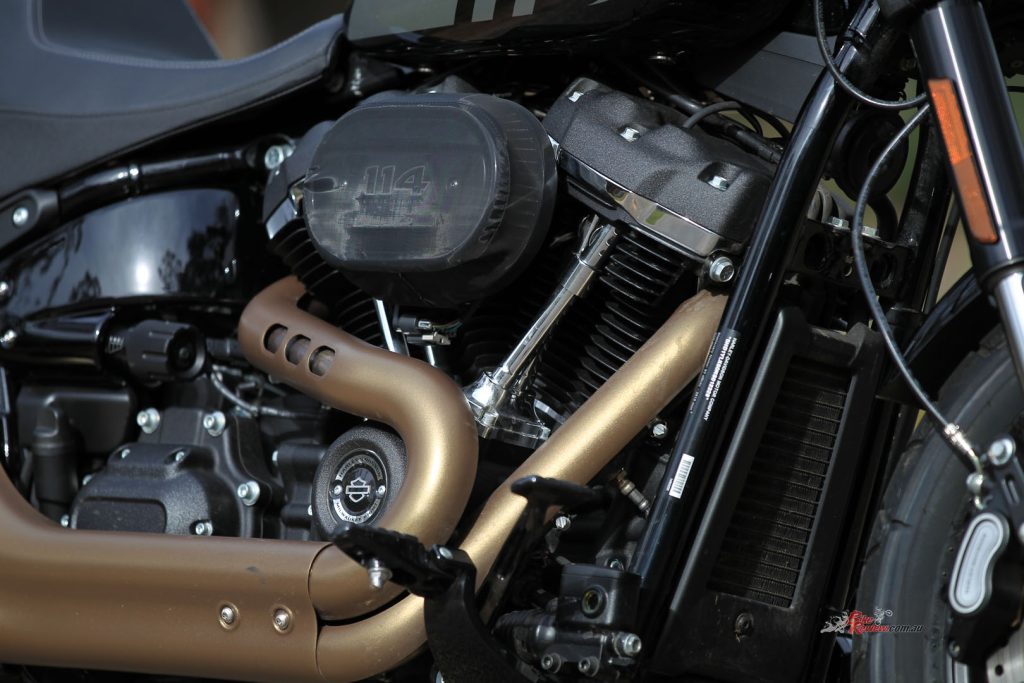
Four-valve cylinder heads (two exhaust and two intake valves per head, eight total) promote airflow through the engine and contributes to power output.
Four-valve cylinder heads (two exhaust and two intake valves per head, eight total) promote airflow through the engine and contribute to power output, and dual spark plugs ensure more complete combustion to maximise power and efficiency. Advanced cylinder head design, dual knock sensors, and precision cooling allow a 10.0:1 compression ratio for strong torque output and acceleration, while a single camshaft helps reduce mechanical noise so a richer exhaust tone can predominate.
Harley-Davidson kept it simple when it came to the electronics, 4-inch analog tachometer with digital speedometer sits the top of the tank, cleaning up the overall look of the handlebars. The LCD screen also displays gear, odometer, fuel level, clock, trip and range indication. ABS is included as standard as well as a keyless starting system.
The lighting throughout the Fat Bob is all LED: the low beam, high beam and signature position lamp headlamp; Incandescent bullets Tail/Stop, front and rear signal lights. The front end is dominated by that Mad Max inspired headlight, added a timeless yet futuristic appeal.
2022 Harley-Davidson FXFBS Fat Bob 114 Specifications
Price: From $31,750 (Vivid Black) $32,105 (other colours) R/A
Colours: Vivid Black, Gunship Gray, White Sand Pearl
Warranty: Two-years unlimited km
Claimed Fuel Consumption: 5L/100km (approx 350km range)
Claimed Power: 71kW@4750rpm
Claimed Torque: 161Nm[119lbs-ft]@3000rpm
Wet Weight: 306kg
Fuel capacity: 13.2L
Engine: Air-cooled Milwaukee-Eight 114 V-Twin, 1868cc (114 cu. in.), 102 x 114mm bore x stroke, 10.0:1 compression ratio, two-into-two exhaust
Gearbox: Primary drive: 34/46. Six-speed ratios – 1st: 9.311, 6.454, 4.793, 3.882, 3.307 6th: 2.79 Final Belt 34/46 Clutch: Wet multi-plate, cable actuation
Chassis: Mild steeltubular frame
Rake: 28° Trail: 132mm
Suspension: Single cartridge 43 mm inverted with aluminium fork triple clamps; triple rate spring(f) Hidden, free piston, coil-over monoshock; 56mm stroke; toolless hydraulic preload adjustment (r)
Brakes: Front and rear black, Split 7-spoke floating rotors 4-piston fixed front and 2-piston floating rear, ABS
Wheels & Tyres: Denim black, Structure cast aluminium with laser etched graphics, 150/80-16in (f), 180/70B-16in (r), Dunlop
DIMENSIONS
Wheelbase: 1615mm
Seat height: 710mm
Ground clearance: 120mm
Overall Length: 2340mm
Lean Angle: 31°(r) 32°(L)
Instruments: 4-inch analog tachometer with digital speedometer, gear, odometer, fuel level, clock, trip and range indication.
Editor’s Note: If you are reading this article on any website other than BikeReview.com.au, please report it to BikeReview via our contact page, as it has been stolen or re-published without authority.
The Verdict | Review: 2022 Harley-Davidson FXFBS Fat Bob


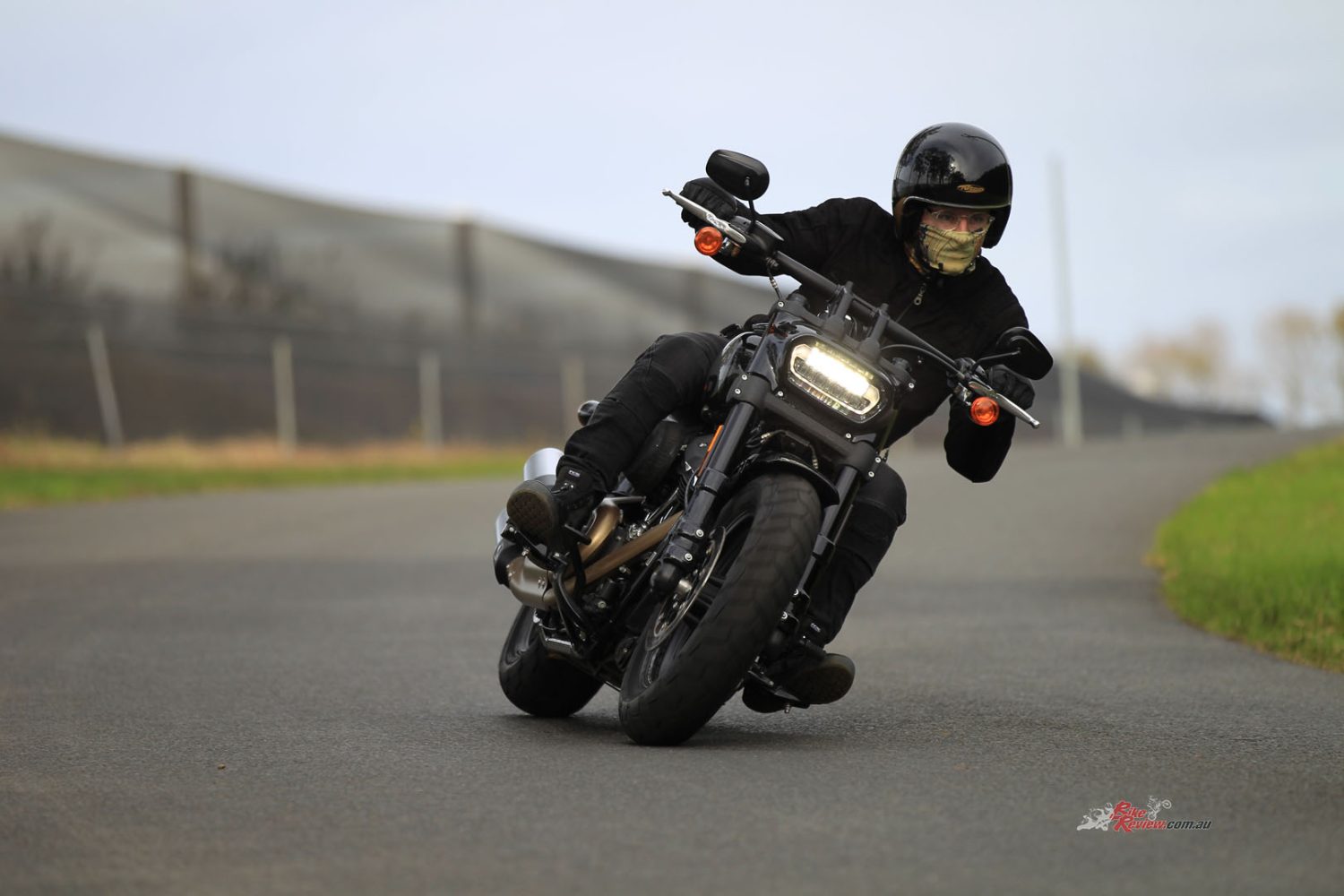
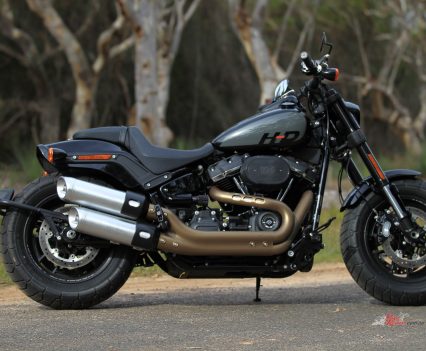
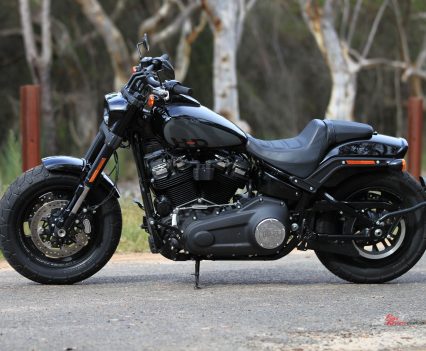
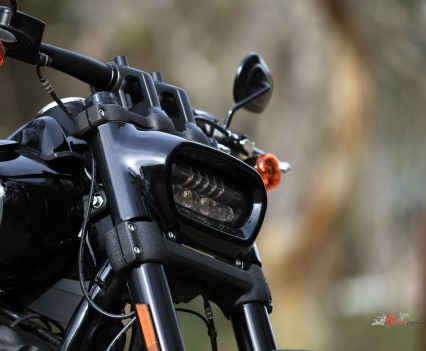
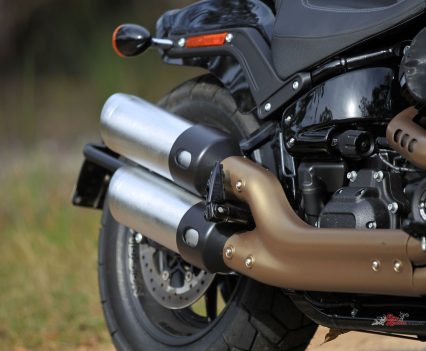
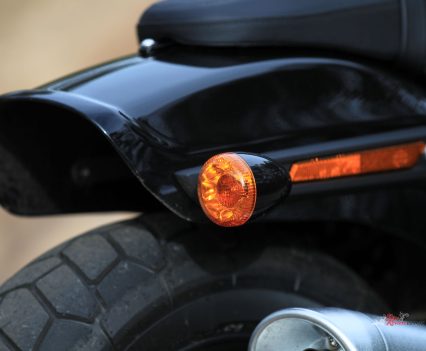
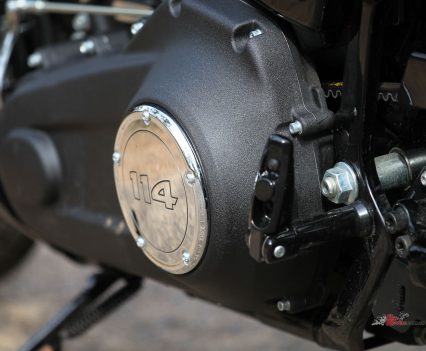
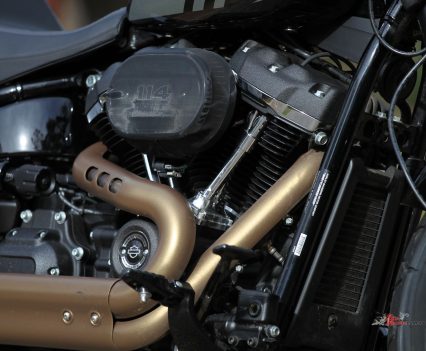
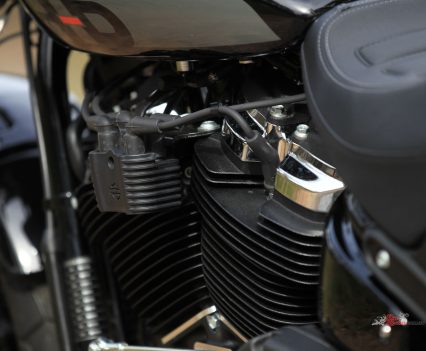
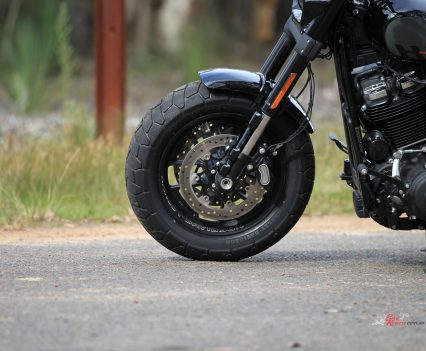
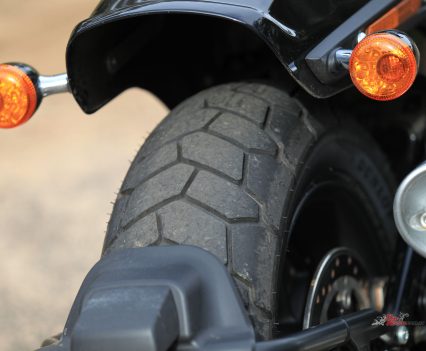
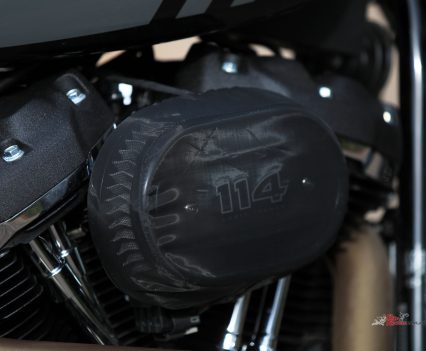
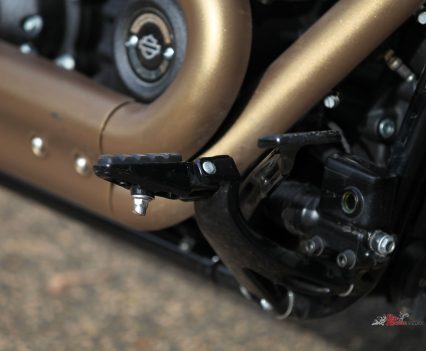
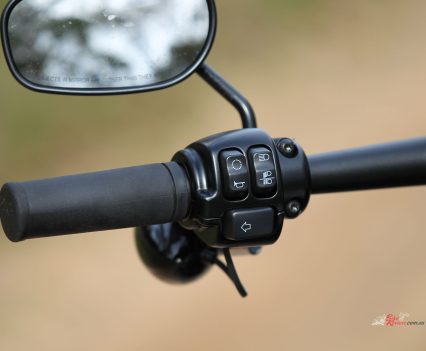
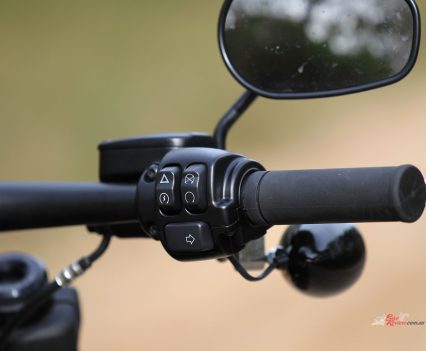
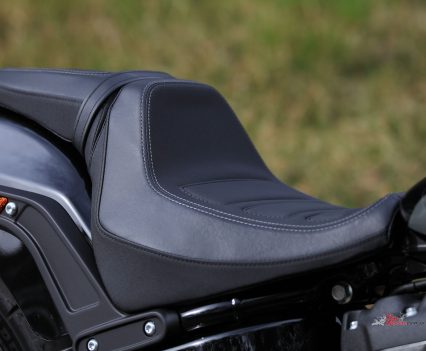
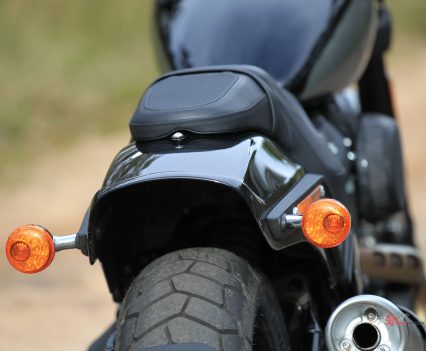
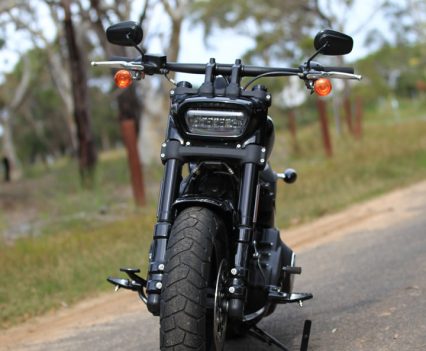
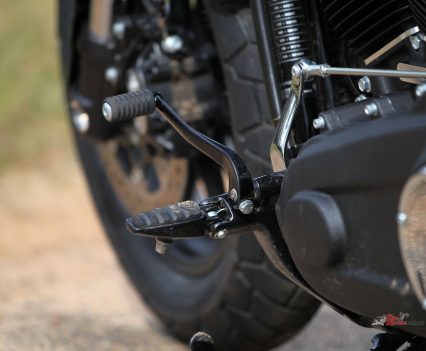
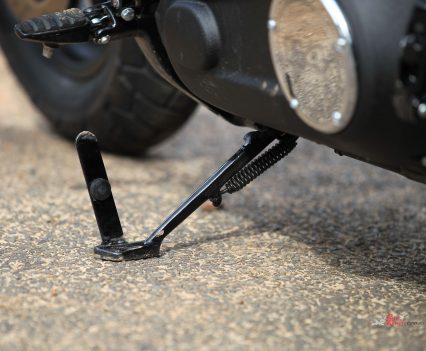
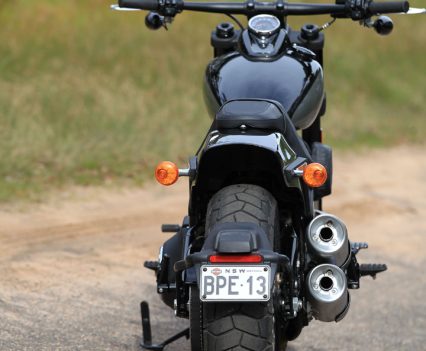
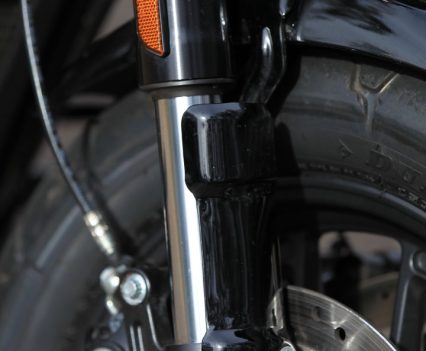
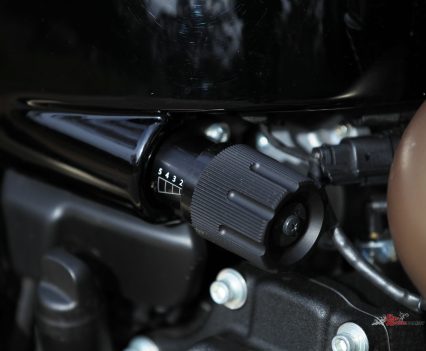
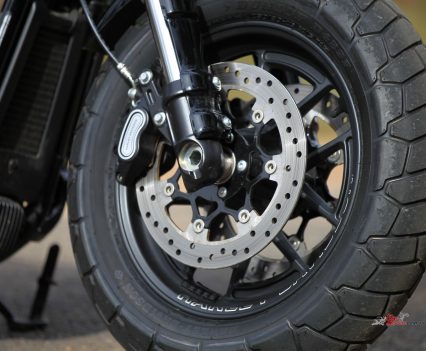
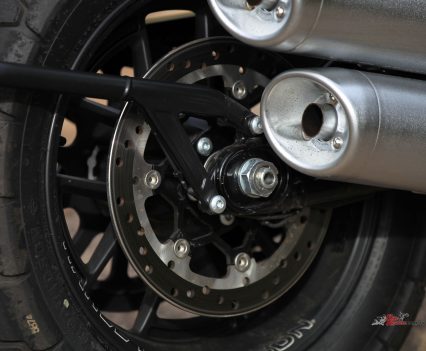
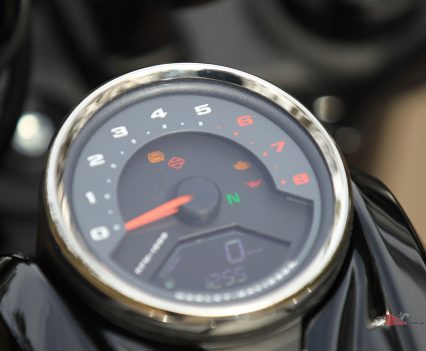
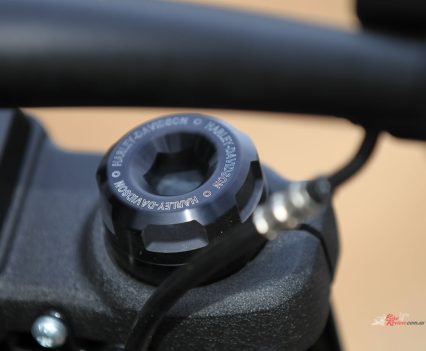

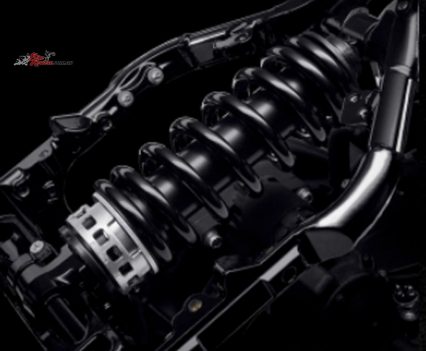
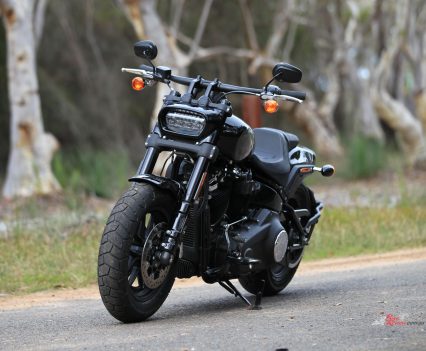
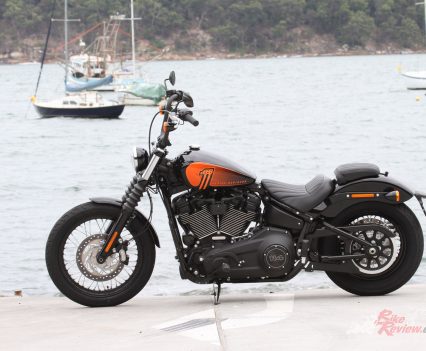
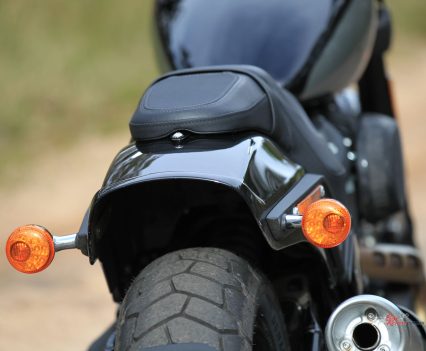

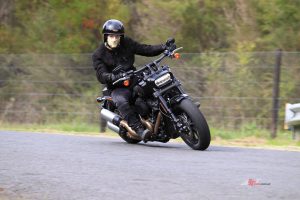
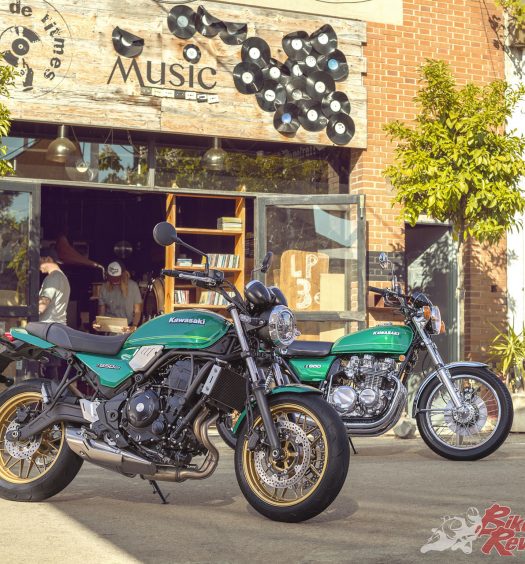
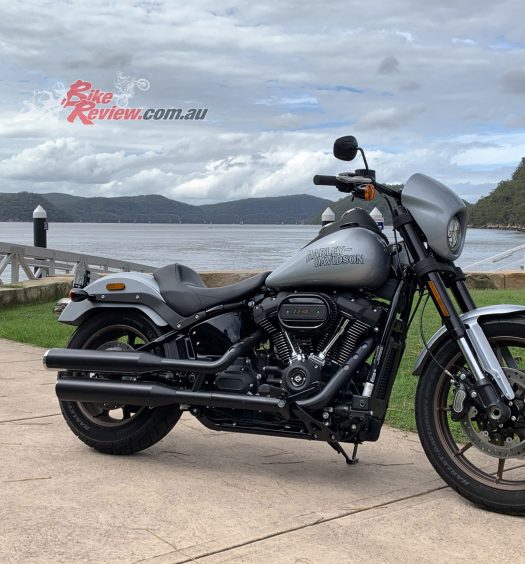




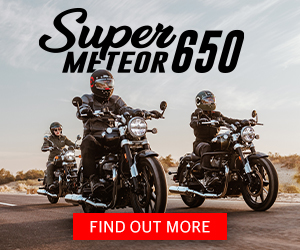

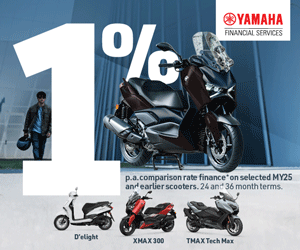







March 5, 2023
The very first thing to do with this bike is to fit some Metzeler Cruisetecs. Completely transforms the handling.